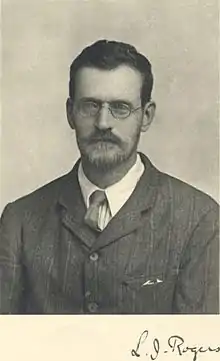Leonard James Rogers
Leonard James Rogers FRS[1] (30 March 1862 – 12 September 1933) was a British mathematician who was the first to discover the Rogers–Ramanujan identity and Hölder's inequality, and who introduced Rogers polynomials.[2] The Rogers–Szegő polynomials are named after him.

Life
He born in Oxford, the second son of James Edwin Thorold Rogers and his second wife Anne Reynolds, and brother of Annie Rogers.[3] He matriculated at Balliol College, Oxford, graduating B.A. and B.Mus. 1884, M.A. in 1887. He became lecturer in mathematics at Wadham College in 1885.[4]
From 1888 to 1919 Rogers was Professor of Mathematics at the Yorkshire College—then an external college of University of London—which became the University of Leeds in 1904. In 1919 he retired because of bad health.[3]
Rogers worked initially on reciprocants in the theory of differential invariants, and then moved into the area of special functions, where he anticipated results of Ramanujan. He was elected a fellow of the Royal Society in 1924.[3] In the late 1920s, he published in the Mathematical Gazette four notes on geometrical problems, including on Malfatti's Problem.
Rogers died on 12 September 1933, in Oxford.[3]
Publications
- Rogers, L. J. (February 1888), "An extension of a certain theorem in inequalities", Messenger of Mathematics, New Series, XVII (10): 145–150, JFM 20.0254.02, archived from the original on August 21, 2007. The first paper containing Hölder's inequality.
- Rogers, L. J. (April 12, 1894), "Second Memoir on the Expansion of certain Infinite Products", Proceedings of the London Mathematical Society, s1, 25 (1): 318–343, doi:10.1112/plms/s1-25.1.318, JFM 25.0432.01 Alt URL. The first paper containing the Rogers–Ramanujan identities.
References
- D., A. L. (1934). "Leonard James Rogers. 1862-1933". Obituary Notices of Fellows of the Royal Society. 1 (3): 299–301. doi:10.1098/rsbm.1934.0013. JSTOR 768830.
- O'Connor, John J.; Robertson, Edmund F., "Leonard James Rogers", MacTutor History of Mathematics archive, University of St Andrews.
- McConnell, Anita. "Rogers, Leonard James". Oxford Dictionary of National Biography (online ed.). Oxford University Press. doi:10.1093/ref:odnb/35815. (Subscription or UK public library membership required.)
- Foster, Joseph (1888–1892). . Alumni Oxonienses: the Members of the University of Oxford, 1715–1886. Oxford: Parker and Co – via Wikisource.